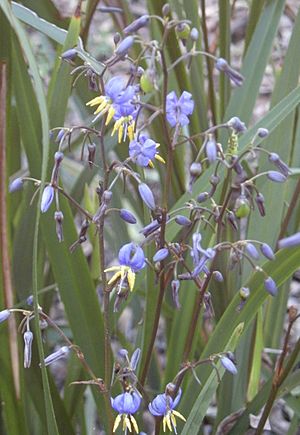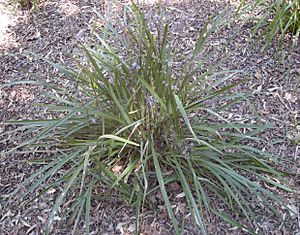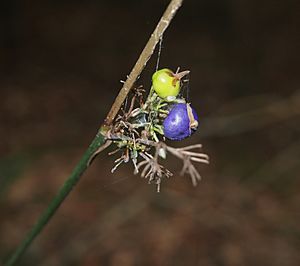Blue flax-lily facts for kids
Quick facts for kids Blue flax-lily |
|
|---|---|
 |
|
| At Mount Archer National Park, Queensland | |
| Scientific classification |
The Dianella caerulea, also known as the blue flax-lily, blueberry lily, or paroo lily, is a cool plant found in eastern Australia and Tasmania. It's a type of perennial herb, which means it lives for more than two years. This plant can grow up to one meter (about 3 feet) tall. It has long, dark green leaves that look like blades of grass. In spring and summer, it shows off beautiful blue flowers. After the flowers, it grows small, indigo-colored berries. This plant is easy to grow and is often seen in Australian gardens.
Contents
About Its Name
The Dianella caerulea was first described by an English plant expert named John Sims in 1802. He wrote about it in a magazine called Curtis' Botanical Magazine.
The name caerulea comes from a Latin word that means "blue." The first part of its name, Dianella, is inspired by the Roman goddess Diana. The "-ella" part means "little," so it's like "little Diana's plant."
This plant is very diverse, meaning it has many different forms. You can find various types of Dianella caerulea all over eastern Australia. For example, in the Sydney area alone, there are six known types! Plant experts have identified seven main varieties of this species. Some grow taller, some are smaller, and some have slightly different leaf colors.
What It Looks Like
The Dianella caerulea is a plant that grows up to about one meter (3 feet) tall. It has long, strap-like leaves that are bright green. These leaves can be up to 75 centimeters (30 inches) long. Under the ground, it has thick roots called a rhizome that help it spread.
Its small flowers, which are about 1 to 1.6 centimeters (0.4 to 0.6 inches) wide, bloom in spring and summer. The flowers can be pale blue, dark blue, or even greenish-blue. In the middle of the flower, you'll see yellowy-brown parts called anthers. After the flowers, the plant grows small, round, indigo-colored berries. These berries are about 0.7 to 1.2 centimeters (0.3 to 0.5 inches) across. Good news: these berries are safe to eat!
Where It Grows
You can find the Dianella caerulea plant in many places across Victoria, New South Wales, Tasmania, and Queensland in Australia. It grows in different types of environments. You might see it in coastal areas, like sandy beaches, or in heathland.
Growing It in Your Garden
People believe this plant was first grown in England in 1783. Today, the Dianella caerulea is a popular plant for gardens. It's also used in public parks and other green spaces as a low hedge.
This plant is very tough and can live for a long time once it's settled. It's great for rock gardens. It can handle wet conditions but prefers soil that is moist and drains well. It's easy to grow and adapts well to different garden settings. In gardens, its berries attract birds, and its flowers can attract butterflies. The smaller, bushier types are especially good for smaller gardens.
Plant Hardiness
The Dianella caerulea is a very strong plant. It can handle snow and frost once it has grown roots. It likes moist, well-drained soil but can also tolerate damp places. This plant is very easy to grow in many different conditions.
See also
 In Spanish: Dianella caerulea para niños
In Spanish: Dianella caerulea para niños




